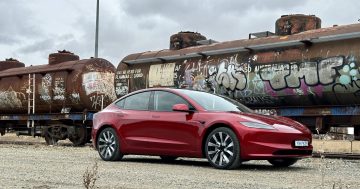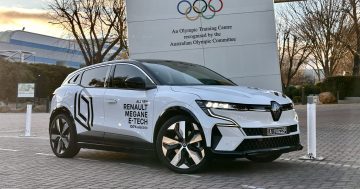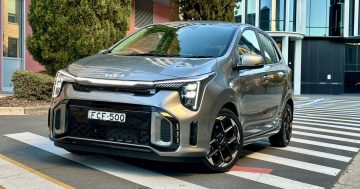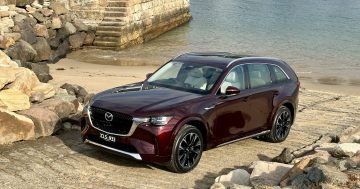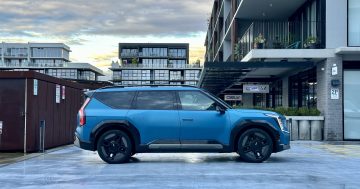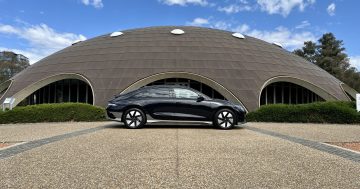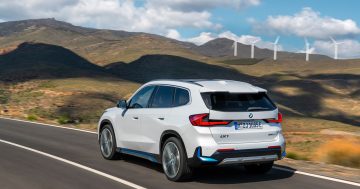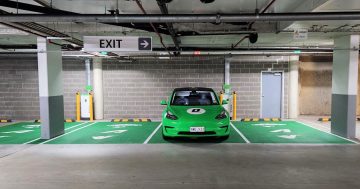By Karl Peskett.
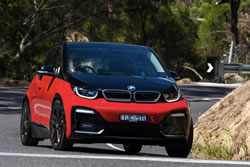 For someone who has had petrol coursing through their veins since being a tiny tacker, the thought of electric vehicles (EVs) taking over the world is a little abrasive. I get the appeal – instant torque and plenty of it – but to give up the dino-juice is like giving up coffee; there will be plenty of headaches along the way.
For someone who has had petrol coursing through their veins since being a tiny tacker, the thought of electric vehicles (EVs) taking over the world is a little abrasive. I get the appeal – instant torque and plenty of it – but to give up the dino-juice is like giving up coffee; there will be plenty of headaches along the way.
Trepidation ensued when it was time to collect this week’s test vehicle, the BMW i3s. It’s definitely not the prettiest thing, but it’s certainly quirky and very interesting. Some of the detailing is very cool, and kitted out in the black, grey and blue colour scheme of our test car, it started to grow on me over the week.
Initially, the practicality (or lack thereof) stood out. The boot is only 260 litres, but thankfully if you drop the rear seats, it grows to 1100 litres. But more of a concern was the suicide door setup. Unlike some “coach-door” vehicles, the i3s won’t allow back passengers to enter or exit without the front door being opened first. That means if you’re in the back and you want to get out, you have to wait for the person in front to get out. It’s a bit frustrating, but once you get used to the routine, it can work.
 That said, the space in the back seats is impressive, given the diminutive size of this EV. There’s heaps of headroom and enough legroom for most people. It’s worth noting, though, that it’s strictly a four seater. Up front, since there’s no transmission, there’s no space-hogging tunnel between the driver and passenger, giving a feeling of more space. And there’s plenty of light coming in from the expanse of glass. Thus, despite being a small car, it doesn’t feel overly small inside.
That said, the space in the back seats is impressive, given the diminutive size of this EV. There’s heaps of headroom and enough legroom for most people. It’s worth noting, though, that it’s strictly a four seater. Up front, since there’s no transmission, there’s no space-hogging tunnel between the driver and passenger, giving a feeling of more space. And there’s plenty of light coming in from the expanse of glass. Thus, despite being a small car, it doesn’t feel overly small inside.
It’s well stocked, too. As standard there’s a 10.2-inch screen for the iDrive infotainment system, DAB, satellite navigation and plenty of active safety systems too, such as forward-collision warning, adaptive cruise and blind spot monitoring. Our test vehicle had the Comfort Package, which adds keyless entry and start, seat heaters (perfect for these winter days) and a 12-speaker Harmon-Kardon audio system that replaces the standard four-speaker setup and full leather. That alone is worth the extra $2000.
Getting used to the start procedure takes a little while. There’s no gear lever, just a stubby rotating handle on the end of a thick stalk which houses the start button and park button. Once started (you’ll need to rely on the screen as there’s no engine) you rotate for drive and the other way for reverse.

Up front is a tiny screen which features speed, driver assist systems, battery charge level and estimated range. And it’s that figure on which you’ll be keeping your eye for the first few days. Once you get used to its accuracy, you learn to trust it and then drive accordingly. On a full charge, you’ll get 200km from the i3s, especially if you’re being conservative with your driving. Put the boot in too much and it will drain quicker – just like a petrol powered car.
But to help its range, BMW has built it as light as possible. With a heap of special polymers, carbon fibre and eco-friendly materials being used, it doesn’t weigh much at all. And then, you add the battery pack. Not quite as light anymore, but at a smidge under 1200kg, it’s still lighter than most small hatches out there.
You may have noticed that this is the “s” version of the i3, so it adds an extra 10kW and 20Nm to give a total of 135kW and 270Nm of torque. This gives it a 0-100kmh time of 6.9 seconds compared with 7.3 seconds for the regular model. But in practice, it feels even quicker than that.

In sport mode, there’s an instant punch for fabulous overtaking ability in traffic and even out on the open road, the surge of torque makes the i3s feel very lively indeed. It will hit 60kmh in 3.4 seconds and will carry on to a top speed of 160kmh.
The steering weighting is excellent and the way it turns in is crisp and sharp. With its 20-inch wheels, it actually handles very well also. And despite being rear wheel drive, it just won’t unstick. It feels so neutral through corners, you’d swear it was an all wheel drive vehicle.
There’s a fair bit of road noise from its large wheels, and at high speed a bit of wind noise too, but get the i3s on a smooth road and it’s very quiet indeed. During acceleration there’s a slight whirr which rises in pitch but other than that, it’s silent. Braking is done by regenerating power, so when you take your foot off the accelerator, it slows down like you would with a brake pedal. Don’t worry, there is a brake pedal, too, but you’ll only need that for emergencies or if you want to stop it rolling back on a hill.
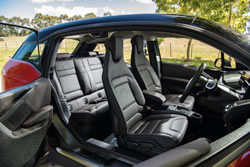 If you’re concerned about that range, there’s a range extender version which gets a two-cylinder petrol motor and a nine-litre fuel tank. Weight increases somewhat, which means it gets to 100kmh in 7.7 seconds but its real-world fuel use of 0.7L/100km is still very commendable. Oh, that range increase takes it up to 330km in total.
If you’re concerned about that range, there’s a range extender version which gets a two-cylinder petrol motor and a nine-litre fuel tank. Weight increases somewhat, which means it gets to 100kmh in 7.7 seconds but its real-world fuel use of 0.7L/100km is still very commendable. Oh, that range increase takes it up to 330km in total.
For the EV version, unless you have BMW’s i-Wallbox, and an optimised charging cable, an 80 per cent top-up from a standard domestic power socket will take 11 hours. Yeah, that needs to be thought about. With the i-Wallbox, the charge time for a full “tank” is just under three hours.
There’s no doubt, the i3s is an amazing drive. It’s fun, different and more efficient than you realise. But that charge time could be the deal breaker. Once you get your head around it, and if you charge while you’re at work, as well as at home, it could be the EV that converts you to this brave new world of motoring.


